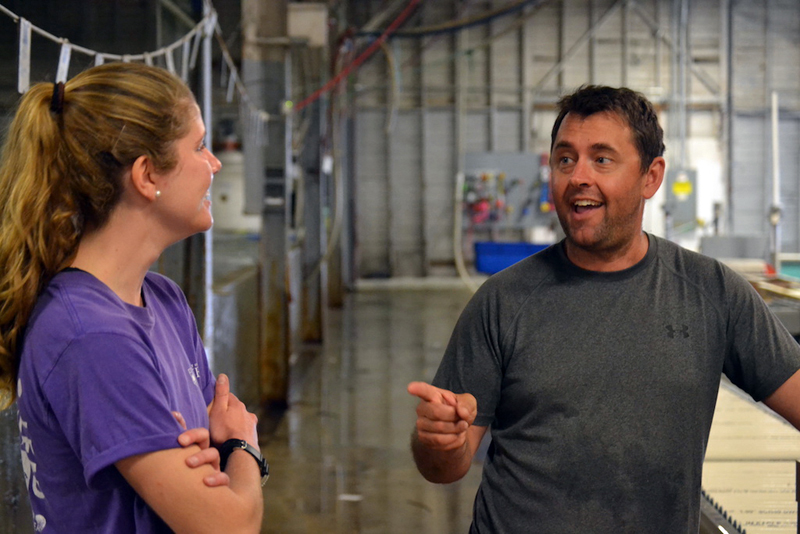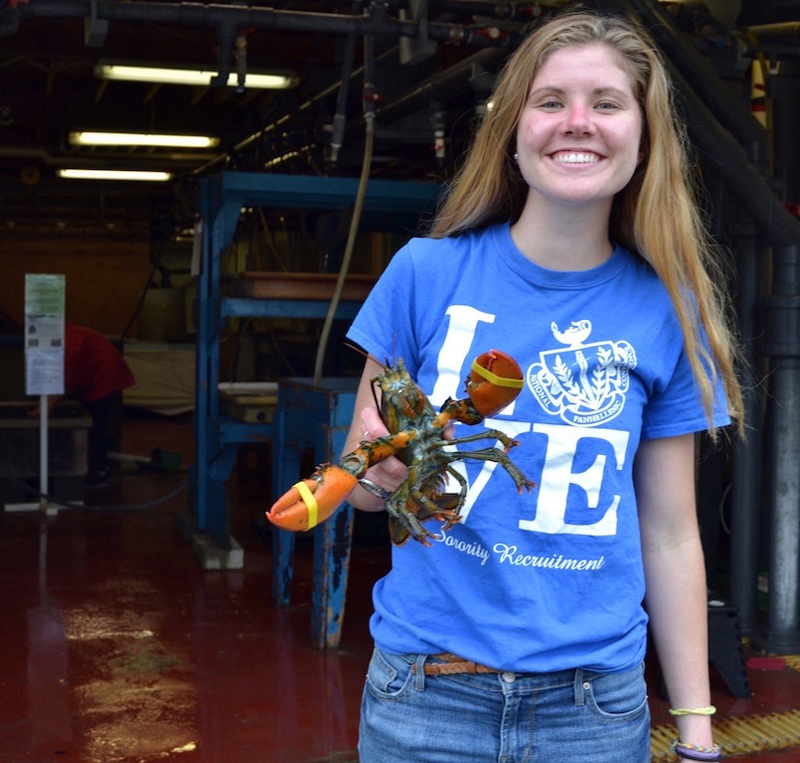
Abby Shaughnessy discusses her research with Curt Brown, UMaine alumnus and a marine biologist at Ready Seafood Co., Portland. (Aliya Uteuova photo)
For Abby Shaughnessy, studying marine biology at the University of Maine was a natural choice. Drawn to the ocean from a young age, Shaughnessy, a senior in the university’s School of Marine Sciences, is spending her summer interning at the Darling Marine Center in Walpole.
For her Honors thesis, Shaughnessy partnered with a Portland-based company Ready Seafood to help make selling lobster overseas more profitable.
Lobster is the most valuable fishery in the United States. With 80 percent of Maine’s total commercial fishery, in 2016, lobster value reached $630 million. As the supply of lobsters has grown dramatically over the past decade, lobster dealers have developed new markets. “Maine is known worldwide for its lobster industry,” Shaughnessy said. “It is important to meet the increasing demand for exported live lobsters.”
Overseas demand for lobsters has grown, especially in Asia and Europe. The challenge for lobster dealers is to keep lobsters alive and healthy for their overseas trip, which can be as long as 72 hours. That’s where shell hardness comes into play. As they grow, lobsters shed their external skeleton and form a new one in a process called molting. At first, the new shell is paper-thin and very delicate, but over the course of a couple of weeks, it hardens up.
To determine price and how far they can be shipped, lobsters are graded based on their shell hardness. “Hard-shell” is the highest grade, given to lobsters with the hardest possible shells; these lobsters stand the best chance of surviving shipping, have the most meat, and therefore command the highest price. Below that, Grade A is still a hard shell but softer than the hardest shell. Grade B lobster shell bends slightly when squeezed by its sides, and grade C is given to recently molted, still-fragile lobsters.
“The shell quality determines where in the world that lobster ends up,” said Curt Brown, marine biologist at Ready Seafood Co. in Portland. Grade B lobsters are likely to be sold domestically, while the majority of Grade A lobsters are sent to Europe for a higher price. There can be up to a dollar-per-pound difference between these two grades.
Currently, Shaughnessy is working with Grade B lobsters. Her goal is to improve their shell quality in the course of one week. Because of the risks and costs, “most companies won’t keep lobsters for a week,” Shaughnessy said. “They have to take into account the cost of feeding them and there’s a chance that some might molt or even die.”
Each week, Shaughnessy picks up 48 lobsters from Ready Seafood Co. At the Darling Marine Center, she keeps lobsters in individual trays and works to optimize a temperature and feeding regime that will harden their shells.

Abby Shaughnessy (Aliya Uteuova photo)
“The DMC is an outstanding research facility,” Shaughnessy said. “The passion that people here have for marine science is inspiring.”
Shaughnessy spent the fall semester of her junior year at the Darling Marine Center in the Semester by the Sea program. This field-oriented immersion program led Shaughnessy to Dr. Rick Wahle, a faculty member at UMaine and a leading lobster researcher who is now her honors project advisor.
“This project is a great example of how UMaine engages with the fishing industry through in-service undergraduate training opportunities,” Wahle said. “Ready Seafood is one of the biggest and most innovative seafood dealers out there. Curt (Brown) has been a great partner not only because he knows the lobster industry from top to bottom, but he also understands the importance of student mentorship.” Brown is a graduate of UMaine’s dual masters program in marine science and policy. Like Shaughnessy, he worked in The Wahle Lab.
Shaughnessy’s research is funded by the University of Maine System’s Research Reinvestment Fund, which aims to strengthen research and development activities that are critical to the future of Maine businesses.
“It’s a very relevant project to us,” Brown said. “The lobster industry in Maine is such a traditional industry, the way things are done now have been done this way for decades. With Abby’s project, we are asking new questions and potentially making a difference for our industry.”
Shaughnessy will analyze the collected data at UMaine at Orono this fall and will defend her thesis next spring. After graduation, Shaughnessy hopes to travel, gain job experience, and eventually earn her master’s degree in marine biology.
“I can honestly say that my time at the DMC changed my life and made me excited to get out in the field and really experience marine science,” said Shaughnessy.
Shaughnessy’s research is captured on video at facebook.com/darlingmarinecenterumaine.
Located in Walpole, the University of Maine’s Darling Marine Center is an active center of marine research, education, and community engagement. Darling Marine Center scientists and students study coastal and marine ecosystems, as well as the human communities that are a part of them, in Maine and around the world. For more information, go to dmc.umaine.edu.
(Aliya Uteuova is a summer communication intern at the Darling Marine Center in Walpole. She is a University of Maine senior studying journalism and political science and a culture editor of the UMaine newspaper The Maine Campus.)



